Does Incorporating Yoga Improve Pet's Sleep Patterns?
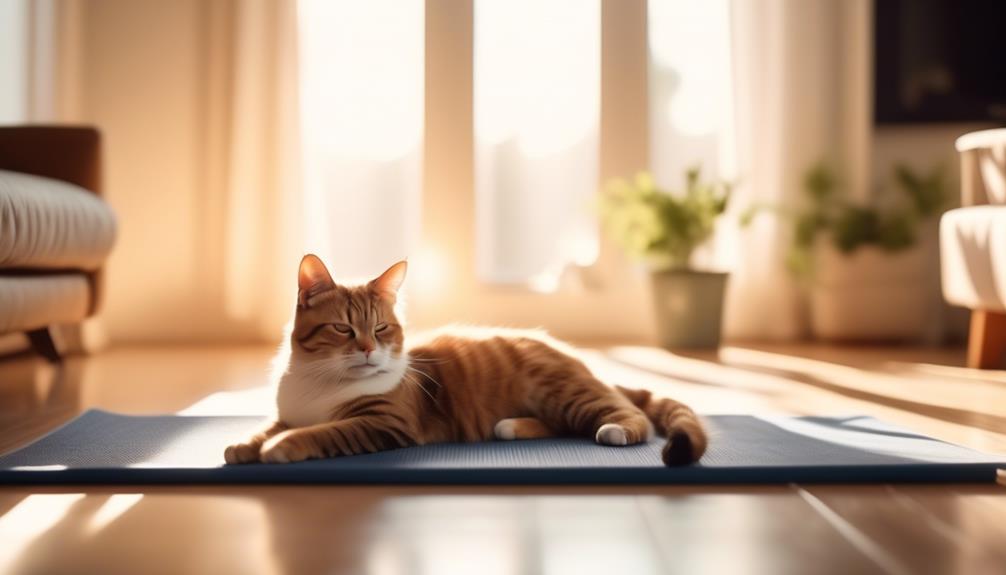
Yoga has been shown to promote relaxation and reduce stress in humans, and it can have similar effects on animals. By introducing yoga poses and stretches to your pet, you can help them release tension and unwind. This can be particularly beneficial for pets that suffer from anxiety or have trouble settling down at night. Regular yoga sessions can also improve their flexibility and joint health, preventing injuries and promoting better mobility. Additionally, the deep breathing exercises practiced during yoga can increase oxygen flow and aid in better sleep. So, incorporating yoga into your pet's routine may potentially improve their sleep patterns, benefiting their overall health and well-being.
Key Takeaways
- Yoga promotes relaxation and reduces stress in pets, which can improve their sleep patterns.
- Incorporating yoga into a pet's routine can enhance their sleep quality by promoting deep and restful sleep.
- The relaxation techniques, stretching exercises, and mind-body connection of yoga contribute to better sleep in pets.
- Creating a designated yoga space, setting a regular yoga schedule, and using positive reinforcement can help establish a successful yoga routine for pets.
The Science Behind Yoga and Sleep

The science behind yoga and sleep reveals the intricate relationship between these two practices and their impact on sleep patterns. Yoga has been found to have a direct effect on the body's circadian rhythm, which is responsible for regulating sleep-wake cycles. Regular practice of yoga helps to synchronize the body's internal clock, making it easier to fall asleep and wake up at consistent times.
One of the key factors in maintaining a healthy sleep-wake cycle is the production of melatonin, a hormone that helps regulate sleep. Studies have shown that yoga can increase the production of melatonin, leading to improved sleep quality. The deep breathing, stretching, and relaxation techniques used in yoga stimulate the parasympathetic nervous system, which promotes the release of melatonin.
In addition to its direct effects on circadian rhythm and melatonin production, yoga also helps to reduce stress and anxiety, two common factors that can disrupt sleep patterns. By practicing yoga, individuals can alleviate tension, calm the mind, and achieve a state of relaxation that's conducive to a good night's sleep.
Understanding the Sleep Patterns of Pets
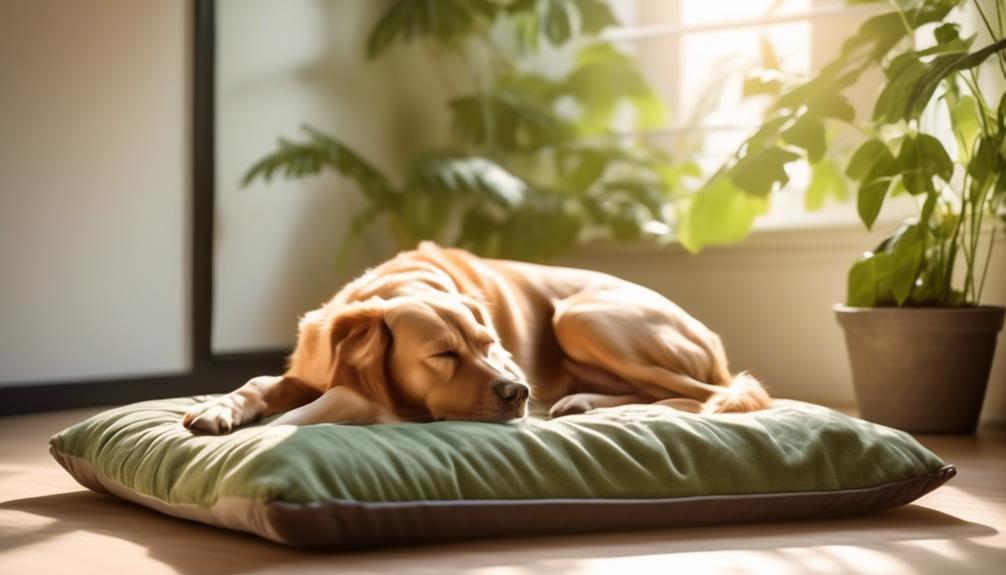
Understanding the sleep patterns of pets is crucial in comprehending the potential impact of yoga on their overall well-being. Different pet species exhibit varying sleep patterns, which can help us understand their unique needs and behaviors.
Dogs, for example, are known to sleep for an average of 12-14 hours a day, with shorter bouts of deep REM sleep. Cats, on the other hand, sleep for about 15 hours a day, with frequent short naps and longer periods of deep sleep. Birds, such as parakeets, have a different sleep pattern altogether. They've short periods of sleep throughout the day and night, as they're adapted to living in environments where they need to remain alert for predators.
It is important to note that just like humans, pets can also experience sleep disorders. Some common sleep disorders in pets include insomnia, sleep apnea, and restless leg syndrome.
Insomnia can manifest as difficulty falling asleep or staying asleep, leading to daytime drowsiness and reduced overall well-being. Sleep apnea, characterized by pauses in breathing during sleep, can disrupt the quality of sleep and lead to excessive fatigue. Restless leg syndrome, often seen in dogs, causes involuntary leg movements during sleep, resulting in disturbed sleep patterns.
Understanding the sleep patterns and potential sleep disorders in pets is essential for providing optimal care. By recognizing their unique needs, pet owners can ensure a conducive sleep environment and address any sleep-related issues promptly. This knowledge also helps in evaluating the potential impact of incorporating yoga into their routine and enhancing their overall sleep quality.
How Yoga Can Benefit Pets' Sleep
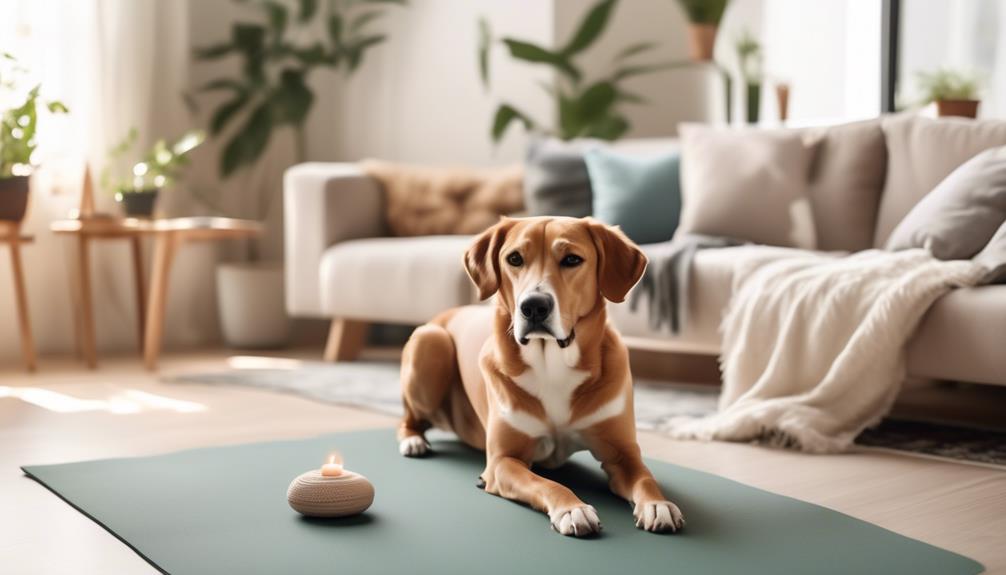
Yoga can have numerous benefits for pets' sleep.
Firstly, it can improve sleep quality by promoting relaxation and reducing stress.
Secondly, practicing yoga can help reduce anxiety levels in pets, leading to a more peaceful and restful sleep.
Improved Sleep Quality
Pets can experience improved sleep quality through the practice of yoga. Yoga for insomnia has been found to be effective in promoting deep and restful sleep in pets.
Here are three ways yoga can benefit pets' sleep:
- Relaxation techniques: Yoga involves various relaxation techniques such as deep breathing and meditation. These practices help calm the mind and release tension, allowing pets to fall asleep more easily and stay asleep throughout the night.
- Stretching exercises: Yoga postures involve gentle stretching of the body. This helps pets release muscle tension and promote blood circulation, leading to a more comfortable sleep experience.
- Mind-body connection: Yoga emphasizes the connection between the mind and body. By practicing yoga, pets develop a heightened awareness of their physical sensations, allowing them to better regulate their sleep patterns and achieve a deeper, more rejuvenating sleep.
Reduced Anxiety Levels
After experiencing improved sleep quality through yoga, pets can also benefit from reduced anxiety levels. Just like humans, pets can experience stress and anxiety, which can negatively impact their sleep patterns. Incorporating yoga into their daily routine can help alleviate these issues.
Yoga provides pets with a range of calming techniques that can help reduce stress and anxiety. Through gentle stretching and controlled breathing exercises, pets can release tension and promote relaxation. These calming techniques can help pets achieve a state of tranquility, making it easier for them to fall asleep and stay asleep throughout the night.
Enhanced Relaxation Response
The relaxation response is enhanced in pets through the practice of yoga, leading to improved sleep patterns. Yoga, known for its stress-relieving benefits, can have a positive impact on pets' mental health, allowing them to achieve a deeper state of relaxation.
Here are three ways in which yoga enhances the relaxation response in pets:
- Controlled Breathing: Through specific breathing techniques, yoga helps pets regulate their breathing patterns, promoting a sense of calmness and reducing stress levels.
- Mindfulness: Yoga encourages pets to be present in the moment, focusing their attention on their bodies and movements. This mindfulness practice helps pets let go of any anxiety or tension they may be experiencing.
- Physical Stretches: Yoga involves gentle stretching exercises that release muscle tension and promote flexibility. These physical movements contribute to overall relaxation and can alleviate any physical discomfort that may disrupt pets' sleep.
Incorporating Yoga Into Your Pet's Routine

Incorporating yoga into your pet's routine can provide numerous health benefits and enhance their overall well-being. By introducing yoga into their daily activities, you can help improve their physical strength, mental clarity, and emotional balance. Here are some tips on how to incorporate yoga into your pet's daily routine:
| Step | Description |
|---|---|
| Step 1 | Start with simple poses that are easy for your pet, such as downward dog or cat-cow pose. |
| Step 2 | Create a designated yoga space for your pet, preferably in a quiet and peaceful area of your home. |
| Step 3 | Set a regular yoga schedule and stick to it. Consistency is key to help your pet adapt and enjoy the practice. |
| Step 4 | Use treats or positive reinforcement to encourage your pet during yoga sessions. |
| Step 5 | Keep the sessions short and gradually increase the duration as your pet becomes more comfortable. |
Incorporating yoga into your pet's routine can stimulate their mind and body, promoting relaxation and reducing stress. It can also strengthen the bond between you and your pet, as you engage in a shared activity. Remember to always listen to your pet's cues and adapt the practice to their needs. With patience and consistency, incorporating yoga into your pet's daily routine can be a rewarding experience for both of you.
Yoga Poses for Better Pet Sleep

To optimize your pet's sleep quality, certain yoga poses can be incorporated into their routine, promoting relaxation and restful slumber. Yoga benefits for cats and yoga poses for dogs can be helpful in improving their sleep patterns. Here are three yoga poses that can aid in enhancing your pet's sleep:
- Cat Pose: This pose is perfect for cats, as it helps stretch their spine and release tension. To perform the cat pose, have your cat start on all fours, with their knees directly under their hips and their hands directly under their shoulders. As they inhale, they can arch their back and lift their tailbone towards the ceiling. As they exhale, they can round their spine and tuck their chin towards their chest. This pose helps relieve stress and promotes relaxation, making it ideal for improving sleep quality.
- Downward-Facing Dog: This pose is beneficial for dogs, as it stretches their entire body and helps calm their mind. To perform the downward-facing dog, have your dog start in a plank position, with their hands directly under their shoulders and their feet hip-width apart. As they exhale, they can lift their hips up towards the ceiling, creating an upside-down V shape. This pose helps release tension in the muscles and encourages a sense of tranquility, leading to better sleep.
- Child's Pose: This pose is suitable for both cats and dogs, as it helps release tension in their back and shoulders. To perform the child's pose, have your pet start on all fours, and then slowly lower their hips towards their heels while reaching their arms forward. They can rest their forehead on the ground and take deep breaths to promote relaxation. This pose helps calm the nervous system and induces a state of deep rest, improving sleep quality.
Incorporating these yoga poses into your pet's routine can provide numerous benefits, including better sleep quality and overall well-being.
Creating a Calming Environment for Yoga Practice
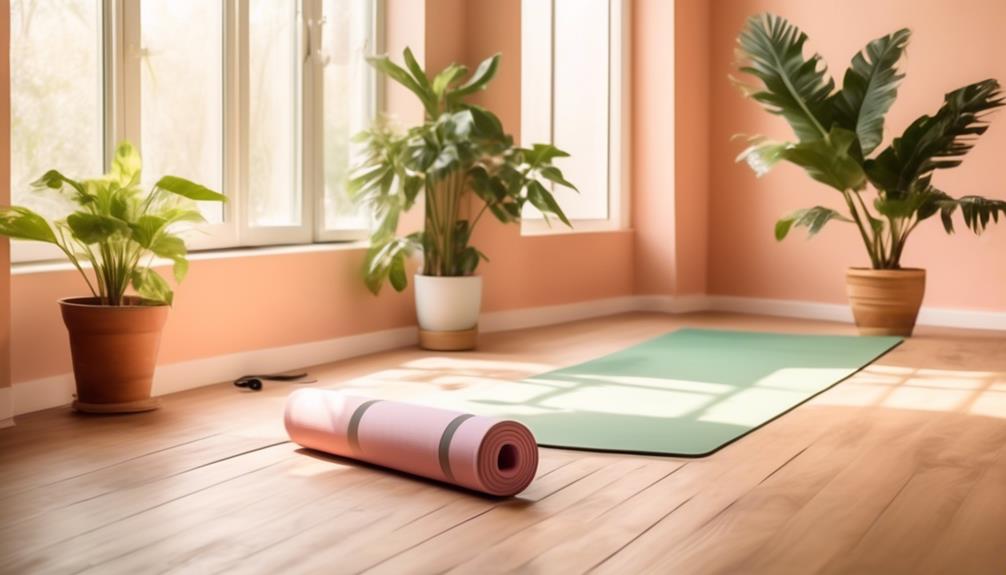
Creating a calming environment for yoga practice is essential for achieving a state of serenity and relaxation. To achieve this, individuals should aim to create serene yoga spaces that promote a sense of tranquility and peace.
Serene Yoga Spaces
A serene yoga space can greatly enhance the overall experience and effectiveness of one's yoga practice. Creating a calming environment is crucial for achieving a state of relaxation and focus during yoga sessions. Here are three key elements to consider when designing a serene yoga space:
- Natural Light: Incorporating large windows or skylights allows for an abundance of natural light, creating a tranquil atmosphere. Sunlight not only brightens the space but also provides a connection to the outside world, promoting a sense of openness and harmony.
- Soft Colors and Natural Materials: Opting for soft, neutral colors like pastels or earth tones can create a soothing ambiance. Using natural materials such as bamboo or cork for flooring, and organic fabrics for cushions and curtains, adds to the overall serenity of the space.
- Tranquil Décor: Integrate elements that evoke a sense of peace and tranquility, such as plants, water features, and calming artwork. These elements can help create a serene atmosphere that promotes relaxation and mindfulness during yoga practice.
Relaxing Ambiance
The design of a yoga space plays a crucial role in establishing a calming atmosphere that promotes relaxation and mindfulness during yoga practice. Creating a soothing atmosphere is essential to help individuals achieve a state of tranquility and focus.
To achieve this, several calming techniques can be implemented. Soft lighting, such as dimmed or natural light, can create a serene ambiance that encourages relaxation. The use of calming colors, such as blues and greens, can also contribute to a soothing environment. Additionally, incorporating elements of nature, such as plants or natural materials, can enhance the overall calming effect.
The arrangement of the space, with minimal clutter and designated areas for yoga props, can also contribute to a sense of tranquility and organization. By carefully considering these elements, one can create a yoga space that promotes relaxation and mindfulness, allowing individuals to fully immerse themselves in their practice.
Tips for Starting a Yoga Routine With Your Pet
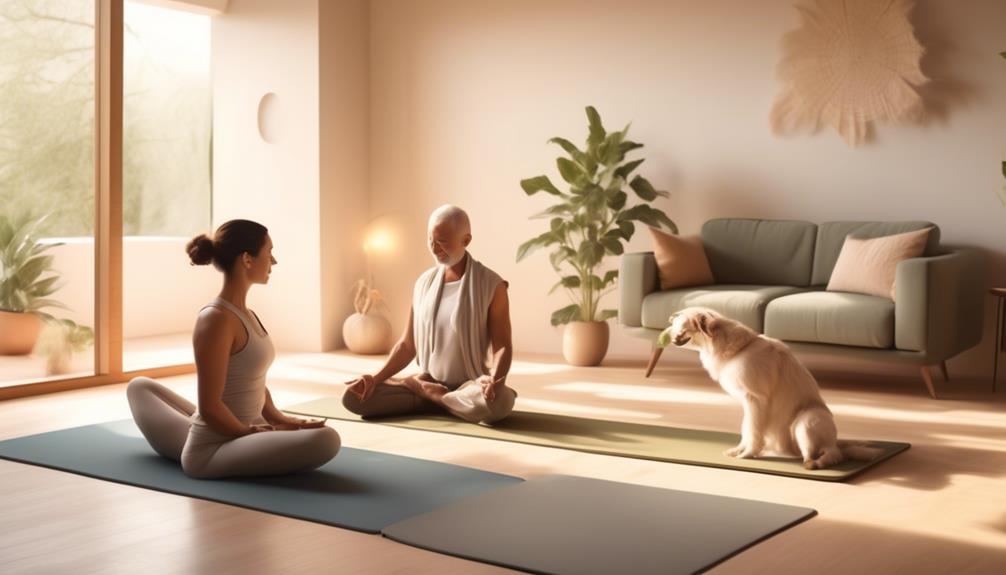
To establish a successful yoga routine with your pet, it's essential to gradually introduce them to the practice while ensuring their comfort and safety. Here are three tips to help you start a yoga routine with your pet:
- Create a calm and inviting space:
Designate an area in your home where you and your pet can practice yoga together. Clear the space of any potential hazards and make it comfortable by laying out a soft mat or blanket. Consider playing relaxing music to create a soothing ambiance.
- Start with simple poses:
Begin your yoga sessions with gentle and easy poses that both you and your pet can comfortably perform. This will help them get accustomed to the practice gradually. Some suitable poses for pets include downward dog, cat-cow, and seated forward fold. Remember to be patient and encourage your pet with positive reinforcement.
- Incorporate bonding exercises:
Aside from traditional yoga poses, include bonding exercises that involve physical contact with your pet. This can include gentle massages, stretches, or even synchronized breathing. These activities won't only deepen your bond but also help your pet relax and enjoy the practice.
Frequently Asked Questions
What Are the Different Types of Yoga That Can Be Incorporated Into a Pet's Routine?
Incorporating yoga into a pet's routine can be beneficial for their overall well-being. There are different types of yoga that can be practiced with pets, such as doga and coga, which can help improve their flexibility and promote relaxation.
Are There Any Specific Yoga Poses That Are More Beneficial for Improving a Pet's Sleep Patterns?
Specific yoga poses for pet's sleep can include gentle stretches like downward dog and child's pose, which promote relaxation and ease tension. Benefits of yoga for pet's sleep include improved circulation and reduced anxiety.
Can Pets of All Ages and Breeds Benefit From Incorporating Yoga Into Their Routine?
Can older pets benefit from incorporating yoga into their routine? Is there a specific age limit for pets to start practicing yoga? Yes, pets of all ages and breeds can benefit from yoga, regardless of their sleep patterns.
How Long Does It Typically Take to See Improvements in a Pet's Sleep Patterns After Starting a Yoga Routine?
Factors affecting the effectiveness of yoga on pet sleep patterns include the individual pet's health, age, and breed. Consistency in a pet's yoga routine plays a crucial role in improving sleep patterns over time.
Are There Any Potential Risks or Precautions to Consider When Practicing Yoga With Pets?
When practicing yoga with pets, it's important to be aware of potential risks and take precautions. Some potential risks include overexertion, injury, or stress on their joints. Precautions to consider include starting with gentle poses and being mindful of their comfort and limitations.









